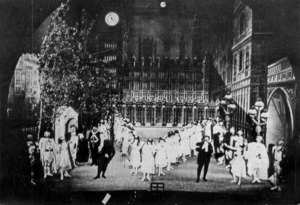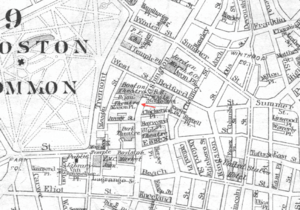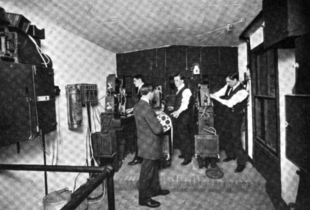Bijou Theatre (Boston) facts for kids
|
Bijou Opera House, Bijou Dream Theatre, B.F. Keith's Bijou Theatre, RKO Bijou Theatre, Intown Theatre
|
|

Bijou interior, 19th century
|
|
| Address | 545 Washington Street Boston, Massachusetts United States |
|---|---|
| Operator | Emerson College |
| Construction | |
| Opened | December 11, 1882 |
| Closed | 1943 |
| Years active | 1882-1943 |
| Architect | Bradlee, Winslow & Wetherell |
The Bijou Theatre was a famous playhouse in Boston, Massachusetts. It was open from 1882 to 1943. You could find it on the second floor of 545 Washington Street. This area is now known as Boston's Theatre District.
A designer named George Wetherell created the theatre's look. People at the time called it "dainty," which means delicate and pretty. The Bijou was known for a special staircase made of heavy glass. Underneath it, an illuminated waterfall flowed, which must have looked amazing! The Bijou Theatre closed its doors on December 31, 1943. The building was later taken down in 1951. Today, part of the building's front still stands. It might even become a special Boston Landmark soon.
History of the Bijou Theatre
The building where the Bijou Theatre stood has a long history. It was first built in 1836 and called The Lion Theatre. Later, in 1839, its name changed to The Melodeon.
In 1878, it became The Gaiety. It also had other names like The Mechanics Institute and Melodeon Varieties. George H. Tyler and Frederick Vokes bought The Gaiety. They wanted to make it the Bijou Theatre. The Bijou officially opened its doors on December 18, 1882.
What Made the Bijou Special?

The Bijou Theatre opened on December 18, 1882. Its first show was a funny musical called Iolanthe by Gilbert and Sullivan. Over the years, the theatre had a few different owners. One famous owner was B.F. Keith, who took over in 1886. In 1901, it was renamed the "Bijou Opera House." Later, in 1927, it became a movie house called "Bijou Dream." It was also known as Intown for a while.
The Bijou was unique for a couple of important reasons:
- First Electric Lights: It was the very first theatre in the United States to use electric lights! The famous inventor Thomas Edison himself installed and checked the lighting system.
- Unusual Exits: The theatre was on the second floor. This meant it didn't have regular exits directly to the street. Instead, its exits led into the lobbies of the two theatres next door. These were the B.F. Keith Theatre and the Keith Memorial Theatre (which is now the Boston Opera House).
After a very serious fire happened in Boston in 1942, new safety rules for buildings became much stricter. Because the Bijou Theatre's exits weren't considered safe enough under these new rules, it had to close down.
Most of the Bijou building was taken down in 2008. However, Emerson College bought the property. They plan to rebuild parts of the Bijou and the nearby Paramount Theatre. They want to use them again as theatres and student dorms.
Images for kids
-
A map from 1886 showing the Bijou next to the Boston Theatre.
-
What the front of the old Bijou building looked like in 2011. It's between the Paramount Theatre (left) and the Boston Opera House (right).
Other Names for the Bijou
The Bijou Theatre was known by several names during its history:
- Bijou Opera House
- Bijou Dream Theatre
- B.F. Keith's Bijou Theatre
- RKO Bijou Theatre
- Intown Theatre





